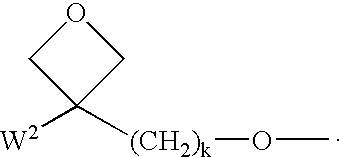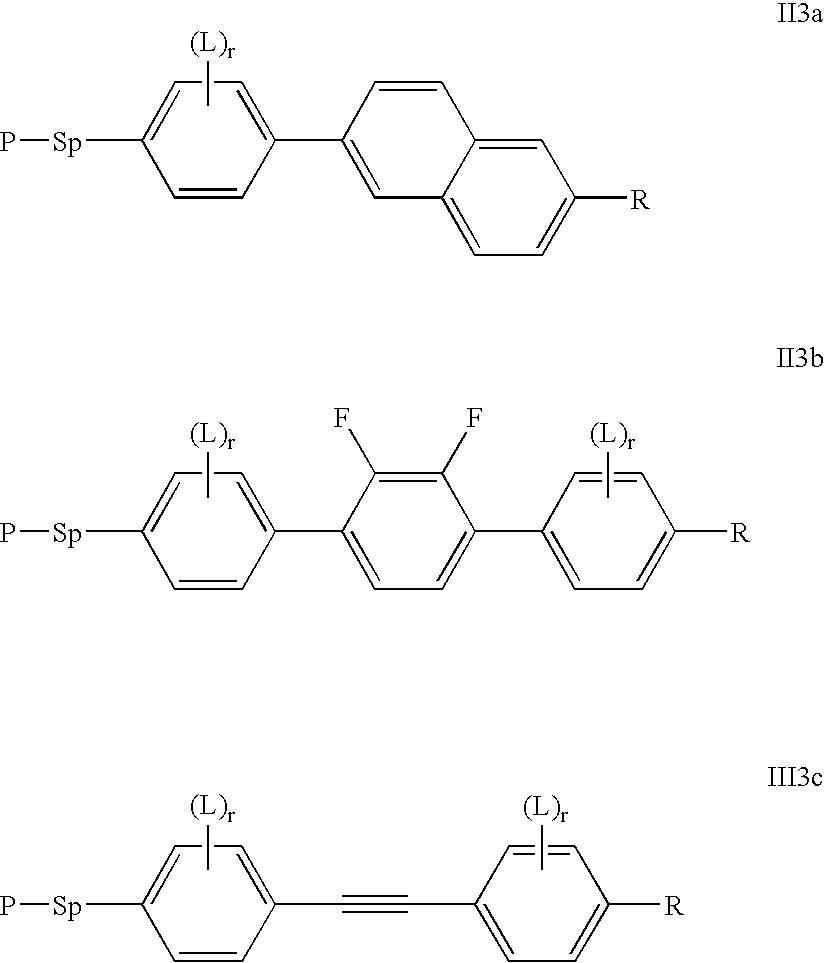Polymerisable charge transport compounds
a charge transport and polymer technology, applied in the direction of sustainable manufacturing/processing, instruments, final product manufacturing, etc., can solve the problems of reducing device performance, reducing the number of polymerisable groups, and not revealing compounds with more than one polymerisable group
- Summary
- Abstract
- Description
- Claims
- Application Information
AI Technical Summary
Benefits of technology
Problems solved by technology
Method used
Image
Examples
example 3
[0120] Compound (7) was prepared as described below 5
[0121] 4-Heptylphenylacetylene (1.1 g, 5.47 mmol) in THF was added dropwise to a solution of DTT compound (6) (2.71 g, 5.47 mmol), triethylamine (20 ml), Pd(PPh.sub.3).sub.2Cl.sub.2 (catalytic) and copper (1) iodide (catalytic) in THF (30 ml) under an atmosphere of nitrogen over a period of 2 hours at 40.degree. C. After 16 h, the solution was allowed to cool to room temperature. The solution was poured in to dichloromethane and washed with water. The DCM layer was removed, dried over sodium sulphate and evaporated to dryness to leave a residual black solid. Purification was achieved by flash column chromatography using DCM:petrol (1:1). On evaporation of the appropriate fractions a yellow solid (0.5 g) was isolated.
[0122] .sup.1H and .sup.13C NMRs showed expected signals.
[0123] The following transitions and phases were observed by optical microscopy using crossed polarisers:
[0124] K-64-I
example 4
[0125] Compound (8) was prepared as described below 6
[0126] Thiophene bisboronate pinacol ester (0.57 g, 1.7 mmol) in THF was added dropwise to a solution of DTT compound (6) (1.68 g, 3.4 mmol) in toluene (30 ml), ethanol (30 ml), Pd(PPh.sub.3).sub.2Cl.sub.2 (catalytic) and sodium carbonate (0.72 g, 6.8 mmol) in water (20 ml) under an atmosphere of nitrogen over a 16 hours at reflux. The solution was allowed to cool to room temperature. The solution was poured in to dichloromethane and washed with water. The DCM layer was removed, dried over sodium sulphate and evaporated to dryness to leave a residual black solid. Purification was achieved by flash column chromatography using DCM:petrol (1:1). On evaporation of the appropriate fractions an orange solid (0.34 g) was isolated.
[0127] .sup.1H and .sup.13C NMRs showed expected signals.
[0128] The following transitions and phases were observed by optical microscopy using crossed polarisers:
[0129] K-66-S.sub.B-71-S.sub.A-200-polymerises
example 5
[0130] Compound (10) was prepared as described below 7
[0131] DTT-bis acetylene compound (9) (0.9 g, 3.69 mmol) in THF was added dropwise to a solution of DTT compound (6) (3.65 g, 7.38 mmol), triethylamine (20 ml), Pd(PPh.sub.3).sub.2Cl.sub.2 (catalytic) and copper (1) iodide (catalytic) in THF (30 ml) under an atmosphere of nitrogen over a period of 2 hours at 40.degree. C. After 16 h, the solution was allowed to cool to room temperature. The solution was poured in to dichloromethane and washed with water. The DCM layer was removed, dried over sodium sulphate and evaporated to dryness to leave a residual black solid. Purification was achieved by flash column chromatography using DCM:petrol (4:1). On evaporation of the appropriate fractions a red solid (0.32 g) was isolated.
[0132] .sup.1H and .sup.13C NMRs showed expected signals.
[0133] The following transitions and phases were observed by optical microscopy using crossed polarisers:
PUM
| Property | Measurement | Unit |
|---|---|---|
| carrier mobilities | aaaaa | aaaaa |
| melting point | aaaaa | aaaaa |
| temperature | aaaaa | aaaaa |
Abstract
Description
Claims
Application Information
 Login to View More
Login to View More - R&D
- Intellectual Property
- Life Sciences
- Materials
- Tech Scout
- Unparalleled Data Quality
- Higher Quality Content
- 60% Fewer Hallucinations
Browse by: Latest US Patents, China's latest patents, Technical Efficacy Thesaurus, Application Domain, Technology Topic, Popular Technical Reports.
© 2025 PatSnap. All rights reserved.Legal|Privacy policy|Modern Slavery Act Transparency Statement|Sitemap|About US| Contact US: help@patsnap.com



